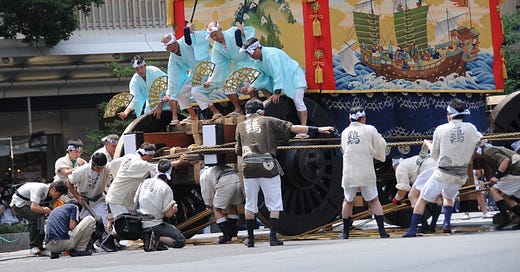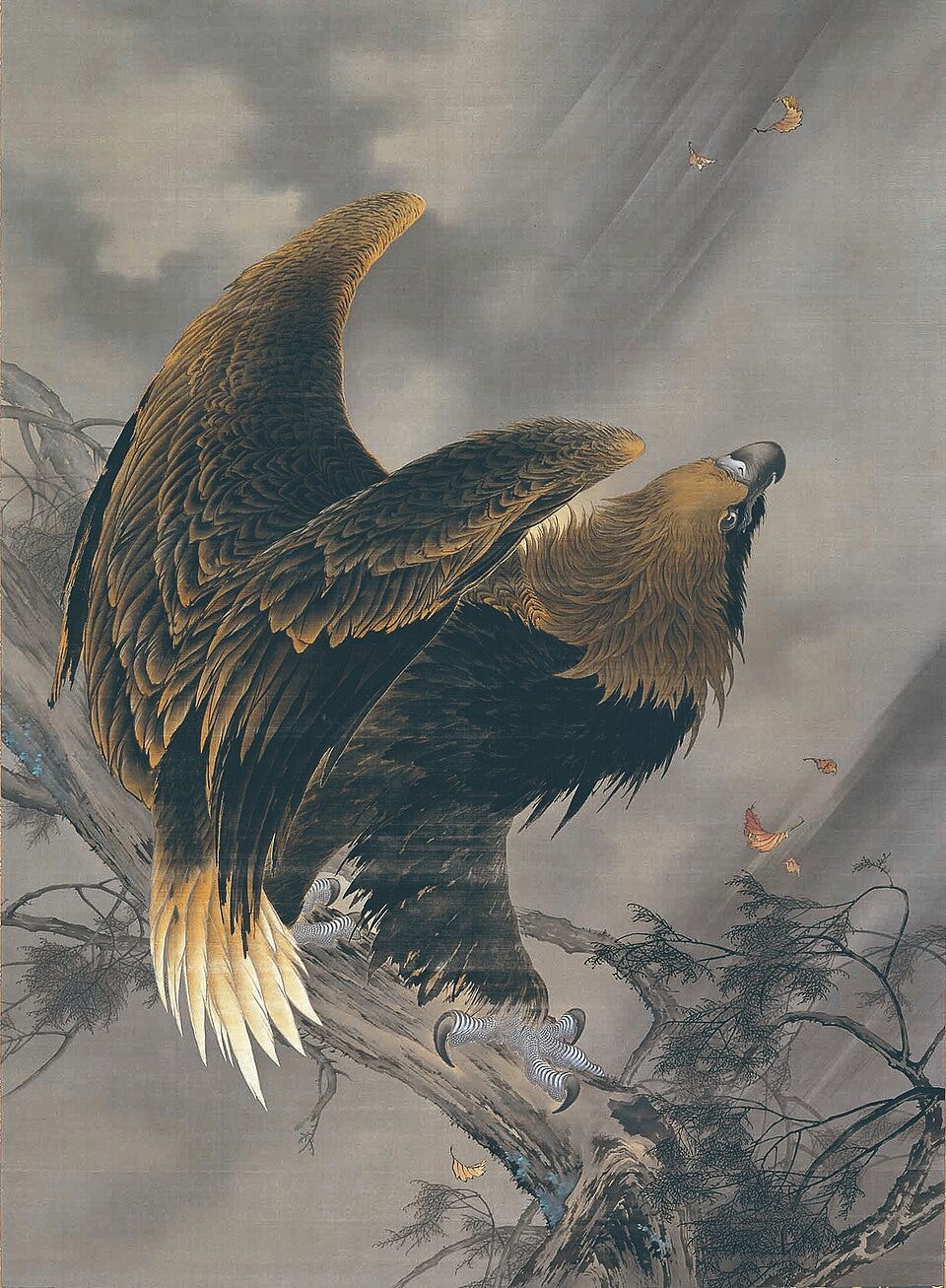Greetings from Kyoto - and from a new newsletter plattform!
As you see, the layout has changed, it’s less colourful with fewer images, I’m still working on importing all the old newsletters into the archives here…
However, everything else will stay the same, just like Gion Matsuri, which has been dominating Kyoto in July for more than 1000 years now. I will try to see some of the smaller events leading up to the two main parades - and these are the main focus of this newsletter edition as well. Enjoy!
Iris Reinbacher, PhD, founder/CEO of WUIK
Kyoto: Up Close and Personal
The Old Kyoto: 470 Years Chiso Kimono
Kyoto’s Gion Matsuri is famous for its two parades, where large yamaboko floats circle the inner city. Thanks to the intricate tapestries that decorate these floats, this ancient shrine festival has a deep connection to Kyoto’s textile industry and silk merchants. And one of Kyoto’s oldest kimono merchants is Chiso, founded in 1555 in Sanjo Muramachi.
From the very beginning, Chiso (then called Chikiriya) specialized in textiles for temples, such as garments for Buddhist priests and fabrics suitable for altar cloths etc., as well as in kimono for all ranks of the aristocracy. This required a deep knowledge of court and temple hierarchies, where each rank was denoted by different colours and patterns and permissible combinations.
The peace of the Edo period brought wide-ranging prosperity to Kyoto, and the inner city was filled with merchants of all kinds; but thanks to the proximity to the Imperial Palace, the textile industry especially flourished. Only a century after its founding, more than 100 shops in Kyoto were owned by Chiso family members or affiliated with them.
However, the citizen’s wealth could not be spent at will. The government established a strict social hierarchy with rules relating to the members of each class. For example, there was a complex dress code regarding fabrics, colours, patterns, even hairstyles and hair ornaments, and when these restrictions weren’t sufficient, additional sumptuary laws were imposed. Donations to shrines and temples were exempt, however, and thus, many of the original tapestries that adorn the Gion Matsuri yamaboko to this day are from the 16th century.
The Meiji Restoration of 1868 changed everything. The old social order was abolished literally overnight, and whoever had money could spend it as they pleased. However, the wealthy now purchased fashionable Western clothing, and kimono, while still widely worn during daily activities, lost their appeal for formal occasions among the upper classes. As a result, many kimono merchants switched to more affordable garments or closed shop altogether.
At the time, Chiso suffered on two fronts: Not only the samurai had disappeared, but the abolishment of Buddhist temples all but eliminated Chiso’s main clients. However, under the leadership of Sozaemon Nishimura XII, Chiso did the opposite: They invited famous artists of the time to create new designs for kimono according to Western influences, and imported chemical dyes allowed for a wide range of vibrant colours, perfect for the new yuzen designs that incorporated fashionable geometric patterns or even Arabian influences.
Also, the ties forged with the Imperial Family during the Edo period paid off when Chiso was invited to produce decorative textiles for interior design use to be shown at international exhibitions like the Paris Expo 1889. Many of the works exhibited there were purchased by private collectors and museums, where they can be found to this day.
A lot has changed since then. Instead of kimono being worn daily, more and more people only take them out for special, traditional occasions. With the shrinking market comes the decrease of traditional craftspeople, and those who are still working often have no successor. Yet, there may be a revival on the horizon: Young people visiting Kyoto now often rent a kimono or yukata to complete their sightseeing experience. This casual approach to wearing this traditional garment may just be what the kimono industry needs, just like when Gion Matsuri returned to holding two parades instead of just one.
While Chiso itself is not directly involved in Gion Matsuri, it is committed to its traditions, just like the people from Kyoto’s inner city hokocho. The company’s headquarters have never moved from their founding place, and the same family - now in its 15th generation - remains at its helm. Chiso continues to produce luxury kimono made exclusively from Japanese silk and with the help of expert craftspeople from Kyoto.
You can experience the luxury of Chiso kimono in their flagship store on Sanjo, where there is also a gallery devoted to their historic kimono collection. Currently, however, to celebrate the company’s 470th anniversary, they show “IZUMI KATO x CHISO: PAINTING IN KIMONO”, a collaboration with a Japanese contemporary artist.
For more Chiso, see the MOMAK exhibition “Secrets of the Kimono: The Advent of Yuzen Dyeing”. It will feature numerous kimono and designs created by Chiso since the Edo period. This one is definitely worth seeing for any (textile) art lover!
IZUMI KATO x CHISO: PAINTING IN KIMONO
at the Chiso Gallery
until Sep 2, 2025
admission: free
SECRETS OF THE KIMONO
at the MOMAK
Jul 17-Sep 15, 2025
admission: 2000 yen (adults)
July Events in Kyoto
Spotlight on: Yumiya-cho’s Warrior Procession
Yumiya-cho is a small neighbourhood centered on Matsubara dori just south of Kennin-ji. As the name suggests, the people who lived there used to produce bows and arrows, and thus belonged to the class of burakumin, who were generally heavily discriminated against. Yet, they also served Yasaka shrine in various functions; one of which was: to guard the shrine’s mikoshi during Gion Matsuri.
Starting probably during the Kamakura period, the mikoshi parade was led by a group of men dressed as warriors following six so-called bo-no-mono, who carried heavy sticks and purified the way ahead of the gods. From 1872 onwards, this group of some 30 “warriors” were selected men from Yumiya-cho, and this tradition continued for many years.
However, keeping armour in good repair is expensive, and when eventually only 14 sets remained, the warrior procession was discontinued in 1974. From that time on, the old armour was displayed by their owners at local homes and businesses during the three days of the first yoiyama.
This year, the warrior procession is being revived. Six people - one “general” and five “privates” - dressed in beautifully restored armour will once more accompany the mikoshi on their way from Yasaka shrine to the Otabisho on Shijo dori. Let’s hope we will see many more of these warriors return!
Armour Decorations of Yumiya-cho Exhibition
July 15, 16; 10:00-17:00
at the Kyusenkaku Community House
admission: free, donations accepted
Yumiya-cho Warrior Procession
July 17, 15:30
start at the Kyusenkaku Community House
admission: free
Don’t miss these events:
performance: Yoiyama Noh
A single great warrior is the main character of this year’s Yoiyama Noh performance: 12th century samurai Minamoto no Yorimasa. In this play, which draws from real history as told in the Heike Monogatari and is set at Byodo-in Temple in Uji, Yorimasa’s ghost appears to a visiting monk and asks him to pray for his soul.
Yoiyama Noh “Yorimasa”
at Inoue Kashokaku Noh Stage
July 23, 2025, 18:00
tickets: 2500 yen (adults) 50 people max; reservations required through the website above
exhibition: Gion Matsuri Now and Then
Gion Matsuri dates back to 869 and has been held annually (with just a handful of exceptions) since 970. The 20th century brought a number of changes to society, like industrialization, war, recession, and the recent pandemic. The exhibition “Gion Matsuri Now and Then” uses interesting historical documents to look at how these challenges affected the ancient festival.
Gion Matsuri Now and Then
at Kyoto City Library of Historical Documents
until Aug 10, 2025
admission: free
markets: Yamaboko Markets
While the religious core of Gion Matsuri are the mikoshi parades, the main attractions are without doubt the 34 yamaboko floats. They are built from scratch every year and can be admired close-up during the respective yoiyama periods. At that time, every float offers unique goods: chimaki, charms, fans, tenugui, goshuin stamps (dedicated fans collect them all)… Get your special gift at these three-day markets and help with the upkeep of the floats at the same time!
Yamaboko Markets
at all hoko and yama floats during yoiyama
July 14-17, 21-23; 10:00-22:00
traditional: Byobu Festival at Sugimoto Residence
In the Edo period, the Sugimoto family was one of Kyoto’s kimono merchants. They started their business in 1743, and their store/residence (from 1870) is one of the largest remaining machiya in Kyoto. During yoiyama, the family invites guests into their house, which is now a National Important Cultural Property. On display are priceless family heirlooms like byobu folding screens and other treasures.
Sugimoto Residence Byobu Festival
Jul 4-6 and 21-23, 10:00-17:00 (Jul 5 only from 13:00); 1500 yen (adults)
Jul 14-16, 10:00-20:00 (Jul 14 only from 17:00); 2000 yen (adults), reservations required
That’s it for today. I hope you’ll have nice summer ahead of you. The next newsletter is out on July 27. Until then: Stay cool!
Iris
Looking for more events?
Check out our full event calendar or find (and follow) us on
facebook — x — instagram









